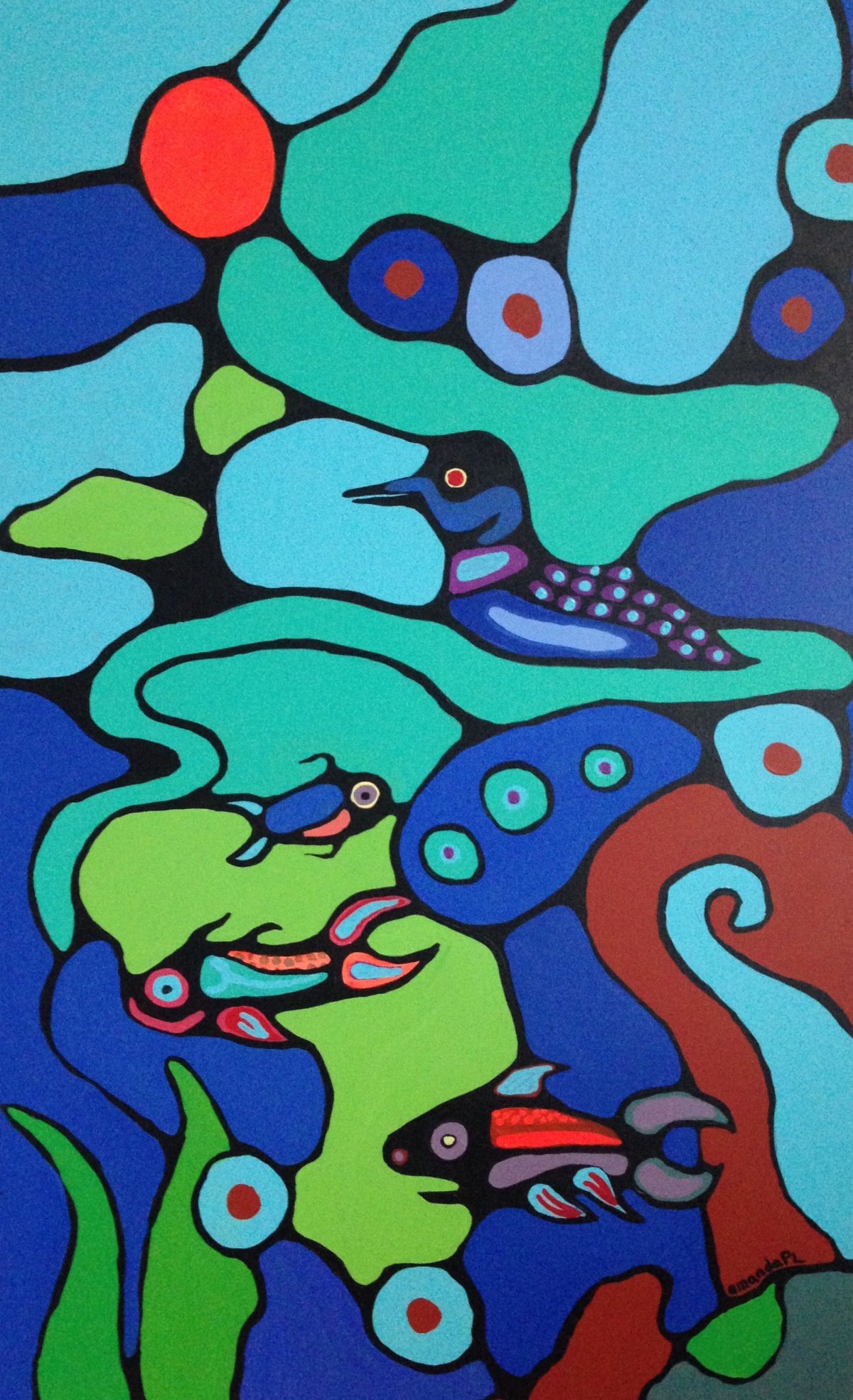
Indigenous activists in Canada have forced the cancellation of an art show in Toronto that drew direct inspiration from indigenous art.
Six years ago, the Canadian painter Amanda PL traveled to Thunder Bay in Ontario to study art education at Lakehead University. There, she became entranced with a lush, surrealistic form of Anishinabe painting known as the Woodlands style. When she returned home to Toronto, where she was born and raised, Amanda PL began to paint Woodland paintings. Next month, she was to have her first solo exhibition, at the new Visions Gallery in the Leslieville district of Toronto.
That show, however, has been canceled because of accusations of cultural appropriation leveled against Amanda PL. That comes only weeks after a similar outcry in New York City, where the Whitney Biennial faced criticism from African-American artists and activists for displaying a work by white painter Dana Schutz that shows the encoffined body of Emmett Till, who was lynched in 1955 in Mississippi.
In canceling Amanda PL's show, which was to open on May 10, the gallery's operators wrote in a statement posted online, "One question is whether it is appropriate to afford a non-Indigenous artist opportunities to show and sell work in the same style as Indigenous artists who don't have similar opportunities. We do not believe so."
Amanda PL obviously disagrees. Speaking by phone from Toronto, she says she is "just Canadian" and offers freely that she has no Native American roots. However, her time studying in Thunder Bay led to an artistic love affair with the Woodlands style of painting. Her instructors encouraged that affair. "I had blessings from a lot of aboriginal people," she tells me.
Her main inspiration is the painter Norval Morrisseau, who was Anishinabe. However, Amanda PL argues, his bright paintings, with their semi-abstracted shapes, borrowed from the European stained-glass tradition. In other words, all art is predicated on "appropriation," which may just be a more loaded word for "influence."

Amanda PL says there was never an attempt to deceive Visions. "They knew...that I wasn't aboriginal. They didn't see any problem with that at the time," she says. It was only after an email went out, she says, and outrage started to build, that Visions decided to cancel the show.
That outrage has been strong. "What she's doing is essentially cultural genocide, because she's taking his stories and retelling them, which bastardized it down the road," one artist of Chippewa heritage told CBC News. "Other people will see her work, and they'll lose the connection between the real stories that are attached to it."
Reached by phone on Thursday afternoon, Tony Magee, one of the two proprietors of Visions Gallery, says that he and his partner were new to the art business, their space having been open for less than half a year. The controversy over Amanda PL's art has been disconcerting—and distracting. Yet he believes that canceling the show was the right call.
"Our society has taken away the land, the freedom, the dignity and even the children of indigenous people," Magee tells me. "And it has done too little to make retribution. They don't have a lot left to claim as their own, not even their art, apparently."
Magee says it was not a hecklers' veto that led to the cancellation but, rather, the dawning realization that Amanda PL's show could cause great offense. "We made the decision because we woke up—and woke up quickly."
The media coverage has sent internet users digging into Amanda PL's past. A YouTube user who goes by the moniker Aqueous Boy unearthed a video in which she and a boyfriend are seen making disparaging remarks about people of Asian descent. Amanda PL tells me the video was "for entertainment/Vines purpose only" and "does not reflect any relation to my artwork or who I am or the values I hold and express in my art."
It is indeed true that the video has no relation to her paintings, but Magee brought it up as a confirmation that he made the right choice in refusing to host her work.
At issue in the cultural appropriation debate is whether any group of people can "own" a set of tropes, ideas or images. Critics of the cultural appropriation concept argue that art cannot be hemmed in by cultural sensitivities and ownership claims. To this group, borrowing is a form of tribute and recognition, as, for example, when white jazz musicians play the music of Louis Armstrong.
Last year, the novelist Lionel Shriver argued against the validity of cultural appropriation claims during a writers' conference in Australia, underscoring her point by wearing a sombrero. "Do we set up a stand on the corner and approach passers-by with a clipboard," she wondered, "getting signatures that grant limited rights to employ an Indonesian character in Chapter 12, the way political volunteers get a candidate on the ballot?"
Yes, say some. Better yet, let only Indonesian writers write about Indonesians, and let only Native Americans paint in a Native American style. To those who make the cultural appropriation accusation, it is valid because ethnic minorities, gays and other groups have been marginalized in Western culture. They should be allowed to speak for themselves, the thinking goes, instead of having white writers or artists speak for them.
Sometimes, the cultural appropriation charge is fair: For example, the fashion designer Marc Jacobs outfitting models in dreadlocks, or the inclusion of "Asian salad" on the menus of restaurants that have no appreciation for the complex, varied cuisines of East Asia.
Of course, you could also just skip the high-minded rhetoric and call that bad taste.
The charge is more complex when it comes to a painting like Schutz's Open Casket, an obviously earnest attempt to grapple with one of the most horrific racial crimes of the 20th century. "The subject matter is not Schutz's," one activist declared. But how did the activist arrive at that determination? It's an especially confounding conclusion because it seems, in a way, to absolve whites from dealing with the Till murder by silencing them when they attempt to do so.
As for Amanda PL, she remains undeterred. "This is my style," she says. She understands why the gallery canceled her show, though she's irked by that decision. "It would be nice if they did back me. But they didn't," she says.
Uncommon Knowledge
Newsweek is committed to challenging conventional wisdom and finding connections in the search for common ground.
Newsweek is committed to challenging conventional wisdom and finding connections in the search for common ground.
About the writer
Alexander Nazaryan is a senior writer at Newsweek covering national affairs.
To read how Newsweek uses AI as a newsroom tool, Click here.








